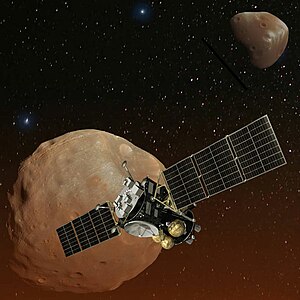Martian Moons Exploration
| Martian Moons Exploration | ||||||||||||||||
|---|---|---|---|---|---|---|---|---|---|---|---|---|---|---|---|---|
 The probe with Phobos and Deimos in the background |
||||||||||||||||
| Mission goal | Exploration of the moons of Mars | |||||||||||||||
| Client | Japan Aerospace Exploration Agency | |||||||||||||||
| Launcher | H-III | |||||||||||||||
| construction | ||||||||||||||||
| Takeoff mass | approx. 3000 kg | |||||||||||||||
| Course of the mission | ||||||||||||||||
| launch pad | Tanegashima Space Center | |||||||||||||||
|
||||||||||||||||
Martian Moons Exploration is a Japanese spacecraft under development to explore the Martian moons Phobos and Deimos . It is scheduled to start in September 2024 , enter an orbit around Mars in August 2025 , land on Phobos and take a soil sample of at least 10 to a maximum of 100 g, then complete several fly-bys to Deimos, leave Mars orbit in 2028 and a return capsule on the in 2029 Settle earth. After the asteroid probes Hayabusa and Hayabusa 2 , Martian Moons Exploration would be the third mission of the Japanese space agency JAXA to bring samples from a small celestial body to Earth.
Instruments
- Gammaspektroskometer and neutron spectrometer (LAGUNA) - Contribution of NASA as part of the Discovery Program .
- Wide angle camera (WAM)
- Infrared spectrometer (MacrOmega) - contribution from CNES .
- Optical radiometer (OROCHI)
- Nadir Telescope for Geomorphology (TENGOO)
- LIDAR
- Martian Dust Monitor (CMDM)
- Mass spectrometer (MSA)
The German Aerospace Center (DLR) and the French space agency CNES are participating in the mission by building a rover (similar to MASCOT at Hayabusa 2) that will be deposited on the surface of Phobos.
Web links
- Hirdy Miyamoto: Japanese mission of the two moons of Mars with sample return from Phobos
- JAXA's exploration of the two moons of Mars, with sample return from Phobos
- Project page
Individual evidence
- ↑ a b Stephen Clark: Phobos sample return mission enters development for 2024 launch spaceflightnow.com on February 20, 2020
- ^ Katherine Brown: NASA Selects Instrument for Future International Mission to Martian Moons nasa.gov
- ↑ MEGANE . JHU APL.
- ↑ http://mmx-news.isas.jaxa.jp/?p=274&lang=en
- ↑ Martian moon mission MMX dlr.de
